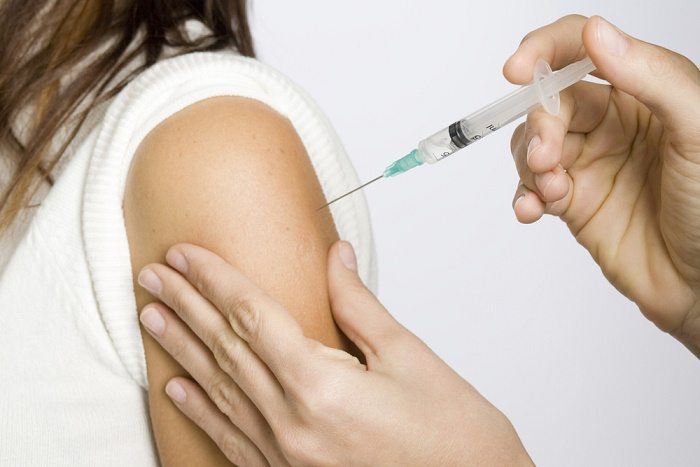Study: States With Low HPV Vaccination Rates See Higher Cervical Cancer Rates
A new study finds that cervical cancer rates and HPV vaccination rates tend to move up and down together, suggesting once again that if more young women get vaccinated there will be fewer cases of cervical cancer.

More proof that vaccinating young people against human papillomavirus (HPV) can prevent cervical cancer was presented this week at a health disparities conference, as a national study found that there are fewer cases of cervical cancer in states in which HPV vaccines are more common.
Distrust of vaccines—based largely on dubious information—and fear that the vaccine might encourage promiscuous sexual behavior among teenage girls could be factors in states with the lowest HPV vaccination rates and the highest cervical cancer occurrences. Numerous studies have shown that the vaccine does not encourage promiscuity.
The study, presented at a conference organized by the American Cancer Research Association, pointed to a number of states on opposite ends of the spectrum. In Massachusetts, for example, 69 percent of girls ages 13 to 17 receive at least one dose of the vaccine, which is given as a series of three shots six months apart, and only six out of 100,000 women are diagnosed with cervical cancer each year.
Sixty-six percent of young women in Vermont have received at least one dose of the vaccine and 5.4 women out of 100,000 are diagnosed each year.
In contrast, 41 percent of girls in Arkansas have received one dose of the vaccine and 10.2 out of 100,000 women are diagnosed with cervical cancer each year. In Mississippi, only 40 percent of girls received one dose of the vaccine and the cervical cancer rate is 9.2 per 100,000 women.
Fifty-seven percent of girls nationally have received one does of the vaccine and the national cervical cancer rate is 8.2 per 100,000 women.
This new study confirms research showing that vaccine rates are much lower in the South than in other parts of the country. A 2013 study of older women, ages 18 to 26, found that between 2008 and 2010, 37.2 percent of young women in the Northeast had received at least one shot compared to 28.7 percent the Midwest and West, and just 14 percent in the South.
The newest study shows that cervical cancer rates and HPV vaccination rates tend to move up and down together. Though the authors could not prove causality, their finding suggest that increasing the uptake of the vaccine in a state could have a direct impact on cervical cancer rates and could help even out existing disparities between states.
Cervical cancer affects about 12,000 women each year in the United States, and about 4,000 women die from the disease.
Worldwide, the numbers are much higher. The clear majority of cervical cancers (91 percent) are caused by HPV, a highly contagious sexually transmitted disease (STD) that is spread from infected skin to uninfected skin. Around 79 million Americans are currently infected with HPV, and about 14 million people become infected each year.
Though the HPV vaccine has been shown to be safe and effective, it has been a tough sell since it came onto the market in 2006. Low vaccination rates reflect a general distrust of vaccines that stems from disproven data released in the late 1990s linking vaccines to the rise in autism.
This explains only part of the problem, because other vaccines are more readily accepted. In fact, the Centers for Disease Control and Prevention estimated in August that if 13-year-old girls had been given the vaccine at the same time they were given the other vaccines recommended for that age, 91.3 percent of them would have received at least one dose.
Some parents seem worried that vaccinating against as sexually transmitted disease would encourage sexual behavior in young girls. Others have said that the recommended age of 11 is too young to even discuss sexual behavior, despite lack of evidence that the vaccine changes a teen’s sexual behavior.
There is a lack of understanding among parents about the HPV vaccine and many parents don’t realize that it can actually prevent cancer.
Perhaps the most important research on the vaccine thus far are studies that show it is working. Despite the low vaccination rates, the proportion of teen girls infected with the strains of HPV that the vaccine addresses has dropped by 56 percent.
This applies to all teens, whether or not they were vaccinated. This may be a result of what public health experts refer to as “herd immunity”—if enough of the population is protected by a vaccine, that protection extends to the un-vaccinated as well. Among girls who had gotten the vaccine, however, the drop in HPV infections was even higher, at 88 percent.
Jennifer Moss, a doctoral student at the University of North Carolina Gillings School of Global Public Health and the author of the new study, told TIME, “These states could really use some interventions to increase the rates of HPV vaccination now, and hopefully there will be big dividends in the coming decades in terms of cancer mortality.”
Moss added that pediatricians play a critically important role.
“The factor that’s most strongly associated with HPV vaccination is whether a child’s health care provider recommends it,” she said. “We really need strong recommendations from health care providers to adolescent patients and their parents to get the vaccine.”
